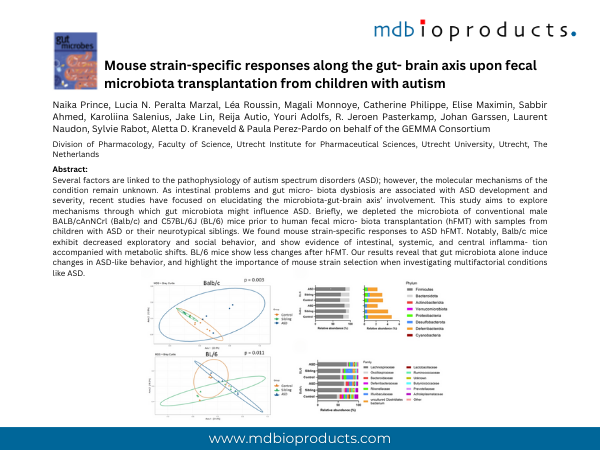
Featured Publication in Focus: Mouse strain-specific responses along the gut-brain axis upon fecal microbiota transplantation from children with autism
Feb 26 , 2025
Authors:
Naika Prince, Lucia N. Peralta Marzal, Léa Roussin, Magali Monnoye, Catherine Philippe, Elise Maximin, Sabbir Ahmed, Karoliina Salenius, Jake Lin, Reija Autio, Youri Adolfs, R. Jeroen Pasterkamp, Johan Garssen, Laurent Naudon, Sylvie Rabot, Aletta D. Kraneveld & Paula Perez-Pardo on behalf of the GEMMA Consortium
Division of Pharmacology, Faculty of Science, Utrecht Institute for Pharmaceutical Sciences, Utrecht University, Utrecht, The Netherlands
Gut Microbes. Taylor & Francis Group
----------------------
Product referenced:
Catalogue # 101001F
Rat Monoclonal Antibody to Mouse T1/ST2 FITC Conjugated
----------------------
ABSTRACT
Several factors are linked to the pathophysiology of autism spectrum disorders (ASD); however, the molecular mechanisms of the condition remain unknown. As intestinal problems and gut micro- biota dysbiosis are associated with ASD development and severity, recent studies have focused on elucidating the microbiota-gut-brain axis’ involvement. This study aims to explore mechanisms through which gut microbiota might influence ASD. Briefly, we depleted the microbiota of conventional male BALB/cAnNCrl (Balb/c) and C57BL/6J (BL/6) mice prior to human fecal micro- biota transplantation (hFMT) with samples from children with ASD or their neurotypical siblings. We found mouse strain-specific responses to ASD hFMT. Notably, Balb/c mice exhibit decreased exploratory and social behavior, and show evidence of intestinal, systemic, and central inflamma- tion accompanied with metabolic shifts. BL/6 mice show less changes after hFMT. Our results reveal that gut microbiota alone induce changes in ASD-like behavior, and highlight the importance of mouse strain selection when investigating multifactorial conditions like ASD.
To continue reading and to download the publication:
